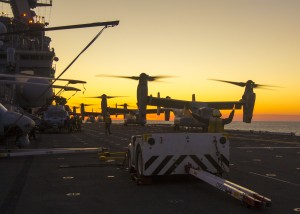Sustaining the ARG-MEU: The Challenge of Distributed Operations
In an interview in 2014, the Lt. Col. Boniface anticipated a number of the key challenges which need to be met to enable the Osprey and the distributed force to have enhanced effectiveness.
2014-03-30 During the visit of the Second Line of Defense team to New River on February 10, 2014, we had a chance to sit down with Lt. Col. Boniface to discuss his most recent experience as the ACE Commander of the 26th MEU, which has just returned from the Middle East.
Lt. Col. Boniface is no stranger to readers of Second Line of Defense, and he has provided us with insights with regard to the evolution of the ACE over the past few years.
A key focus of discussions with Boniface in the past and in the current one are the changes, which the evolution of the ACE has introduced to the ARG-MEU.
A major theme has been with regard to shifting a helo centric ARG-MEU thinking in terms of a 200 mile box of operations to one transformed by the Osprey into operating over a 1000 miles.
This has led to the deployment of three ship formations no longer within a 200-mile area but over more than a 1000-mile area. This leads in turn to a major challenge of re-supplying the ARG-MEU. And the problem seen here is being replicated by the USMC need to pursue a distributed laydown strategy in the Pacific.
Sustainability over distance is a key challenge as the geography covered expands and the ACE assets can operate over those greater distances as well.

Lt. Col. Boniface highlighted two key challenges.
The first is simply the challenge to the Military Sealift Command to support a disbursed ARG-MEU.
The second is having a responsive and effective parts availability pool to support the deployed but dispersed ARG-MEU. This is an especially important challenge for the Osprey because of relatively limited locations within which parts are available to be flown or delivered to the ARG-MEU on deployment.
Put another way, the deployment of the ARG-MEU is not constrained by Osprey operations, but the effectiveness of the logistics or sustainment operations.The carriers get supplied every week; the ARG-MEUs only every 10-14 days. This disparity no longer makes sense given the reality of ARG-MEU operations under the influence of the Osprey.
In effect, there is a tactical limitation posed by sustainment, which can have strategic consequences.
An additional challenge is the load being placed on the USMC Ospreys by resupply to the Navy ships.
About 20 percent of my flight hours on the MEU were used to help the ARG-MEU to do resupply.
We need to get into a different way of thinking to release the Ospreys from this mission.
We need to think through a different rhythm or approach to sustainment from the at sea replenishment system.
SLD: “You were talking about the CV versus the MEU. The MEU historically has been really defined by the box that you described. It’s a helo-defined box, more or less. And, and so as the Osprey now you can operate at a much wider circumference and is much more useful to the joint force with the special purpose MAGTF people are interested from the joint force and the Navy itself is looking at Ospreys for resupplying.
“What that tends to mean is that your hermetically sealed Gator Navy makes no sense.Lt. Col. Boniface: That is exactly what I’m saying. And as we transform the ARG-MEU with the F-35B, the CH-53K, the new Cobra and Huey, we need to significantly rethink the logistics support structure for the deployed fleet. We have gotten out of the helo mindset with regard to operations; but not with regard to sustainment approaches.
Another problem identified by Lt. Col. Boniface is the constraint of having very few supply locations from which Osprey parts can be generated to the deployed force.
Lt. Col. Boniface: We have gotten to the point where it is a very reliable aircraft, but it needs parts to fly. We are at a transition point whereby the flow of parts to the fleet needs to be significantly improved from what will need to become a global supply chain to the aircraft which is being deployed widely now in the Pacific, Europe and the Middle East, and will now be bought by several allies. This really raises the benchmark on global supply of parts to the aircraft on deployment.
It’s not about the plane anymore. It’s about the entire logistics enterprise that sustains operational effectiveness
For earlier interviews with Lt. Col. Boniface see the following:
http://breakingdefense.com/2012/03/bold-alligator-a-glimpse-of-marine-navy-future/
http://sldinfo.com/the-role-of-the-osprey-in-operation-odyssey-dawn/
The featured photo shows an MV-22B Osprey, assigned to the Blue Knights, of Marine Medium Tiltrotor Squadron (VMM) 365 lands on the flight deck of the amphibious assault ship USS Bataan (LHD 5). The ship is underway conducting sea trials. (U.S. Navy photo by Mass Communication Specialist 2nd Class Zachary A. Anderson).
ATANTIC OCEAN (Mar. 12, 2019)

